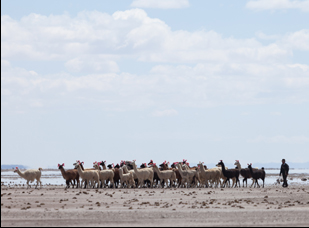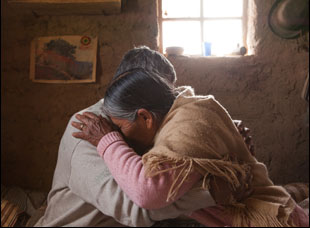There are cracks in the land where Virginio (José Calcina) and Sisa (Luisa Quispe) call home in “Utama,” living in a remote section of the Bolivian Altiplano where they have subsisted for decades with their gaggle of llamas and occasional trips to the nearby river for water. But somehow the bucket has grown heavier for Sisa as she ages, even as there’s less to fill it, with greater periods of drought than there ever have been before, robbing the Quechua community in the region of what little they need to survive. Writer/director Alejandro Loayza Grisi saw something far greater being lost with climate change when he was driving around the hills and valleys that seemed so far away when he was growing up in the urban La Paz, taken with the endless beauty of the landscapes where it seems like the sky can go on forever but matched by people who have gotten by for generations on traditions rather than resources, still using the river for everything from quenching thirst to washing clothes.
After learning that the Quecha community itself was at a tipping point, Grisi conceived of his heartrending feature debut as he sees a family threatened to be torn apart by the best way forward. Although he may have given himself an enormous challenge to coax the real-life couple Calcina and Quispe to imagine they could ever be at odds with one another, the two are seen at loggerheads in “Utama” when they can’t carry on with their farm as they have, with Virginio developing a worrying cough and the ripple effect of the drought gradually overwhelming every aspect of their lives, leading their grandson Clever (Santos Choque) to come in from the city to broker a detente and perhaps move back with him. While Grisi’s background as a cinematographer and stills photographer is evident from every striking frame, he shows an eye for collaborators as well, working with “The Intruder” cinematographer Barbara Alvarez and “Divine Love” editor Fernando Epstein to deliver an engrossing drama where the stakes couldn’t seem higher.
After first taking people’s breath away at Sundance where it picked up the Grand Jury Prize in the World Cinema Dramatic Competition and subsequently selected as Bolivia’s official entry to the Academy Awards, “Utama” is starting its U.S. theatrical run this week and Grisi spoke about how he embarked on a shoot so far away from contemporary comforts, the obstacles he overcame to get the perfect cast and its evocative use of music.

I was able to travel all around Bolivia. I had some ideas in mind for different projects, not just directing, but also photography and documentary projects and I had already this story of an elderly couple living in a very isolated [environment], so when we arrived at this place, it was so magnificent and unique, I thought this is the perfect place for this film.
Is it true you just saw Jose and Luisa standing around and thought these could be movie stars?
Yeah, we were scouting locations and we hadn’t started the casting process yet and I saw [Luisa] first outside her home andI told the driver to stop and I asked her if she wanted to be in a film. At first, she was not interested because [she said], “I don’t know why a film.” [laughs] Then [Jose] came out and I thought they were wonderful. I asked to do some photos of them and we actually used these photos as references for the casting process, but I already wanted them to be so at the end I was very lucky to convince them.
If I may ask, what sold them on it?
I think they saw that we were serious about it because the first time, we were just a car with four people coming from the city and they were just not interested in film because it’s a very different perception they have there. It’s not important. But then they saw we were coming over and over to the same place and we were a big team, so that’s what convinced them at the end.

Yes, he helped me a lot actually. During the casting process, he was with me doing the tests with many different non-actors, elderly people from the place, and he was very generous throughout the entire process. He helped them a lot to be comfortable and quiet and he was generous in his experience to the other actors, so I was very lucky I found him. And there’s a funny story about how we found him also because he’s a more experienced actor and we were trying to call him for the casting, but he was not answering the phone – not messages or e-mail, Facebook, nothing. And one week before we were closing the casting, I was about to choose someone else and he called my brother the producer and he told him, “Hey, this is Santiago, sorry for not answering. I was with no signal in the countryside with my grandparents.” [laughs] We said “No, this is too much of a coincidence. This is perfect.”
I don’t want to spoil the movie magic, but since this location was so remote, I understand you had to have a set of their house for certain scenes. What was it like to recreate?
Since I come from photography, I had a clear picture of how I wanted the film to look and also the house, so I already had some drawings about the place [to help] the location manager to find. We saw some houses, but they were not for rent of course — people were living in there and they didn’t want to stop living there. [laughs] And we figured out it was going to be easier to just build it. We were able to do it according to the sun position for sunrise and sunset and also have walls that could be withdrawn in order to put the camera.
We planned the shooting with the time and weather because in the winter, it’s impossible to be there in June or July, our winter in the south. It can get minus 15 degrees celsius during the night, so there was only one window to shoot the film in September, October, November [and with] Barbara, we decided together [how to] build the house with the position of the sun.

For me, it was the best because she was very experienced, so she helped me be more comfortable in my first film as a director. We worked a long time together during preproduction. I drew an entire storyboard and showed it to her and then we went shot by shot and we already had the same film in both our heads so when we arrived at the shooting, it was like okay, this is what we planned already, so let’s do it. She has a privileged eye, so everything I imagined, it was even better and I didn’t have to worry about the light or anything because she already had it perfectly solved.
Did the llamas behave?
They did. They are a very smart animal and what they brought to the film was joy because they were very lovely to see. They put you in a good mood, and people always say don’t work with animals and children, but I think in this case, it was in our favor.
You’re very meticulous about the use of music in this and how it could pierce the silence. What was it like to figure out?
I had a lot of references for the music in the film. During the writing process, I always wrote with Chopin and I knew the rhythm would’ve been the same with the music. Then at one point in the editing room, Fernando [Epstein] told me, “Okay, I think now it’s a good time to start putting music wherever we need music” and we started trying with many different references. One was precisely from this composer [Cergio Prudencio] who directs an orchestra called Orchestral Experimental Instruments Nativos, and I thought that the music was able to transport you to another place. They have concerts [where] every song is like 25 minutes long and we were using small pieces of it and it was very precise. Then the composer made some arrangements to these already existing songs and adapted them to the precise moment we needed it.
There are two other songs that have been written especially for the film — and I feel the opening song can put you into his state of mind for the character and the final song puts you into her state of mind and feeling. It was very important to me that the final song had a female voice because I feel the ending is about Sisa and her decision and I also wanted to bring hope and if I ended the same film with a different song, I think it could’ve been more pessimistic, more dark, but I feel as soon as the music starts and it’s a happy song, then the audience is able to just breathe.

I feel I know much more than I used to and I learned a lot from the first feature. It was a very nice experience and it can get very stressful. It is difficult to be in a place that is so remote for production. We knew if we had a problem, it could’ve been tragic. If the camera failed for some reason, it would’ve meant stopping for maybe a week or more, and the climate of the place itself is difficult and we were dressed up like desert people.
But for me, it was the best because I was focused only on that. I only had the film in mind and I didn’t have to do anything – no groceries, just going to bed to sleep. I must say that production gave me all the comforts I needed, like they made sure that we had everything for the first day of shooting and it worked like a clock. And we were very far away. but they made sure that everything worked. I was extremely tired by the end of the shooting. This is one lesson I learned – I’m going to go to the beach for two weeks and do nothing [after the next film]. But it was beautiful because I think we were able to build a very strong and united team, so we had fun and that’s the most important thing during the process is to enjoy it.
“Utama” opens on November 4th in New York at Film Forum and November 11th in Chicago at the Gene Siskel Film Center and in Los Angeles at the Laemmle Royal. A full list of cities and dates is here.




